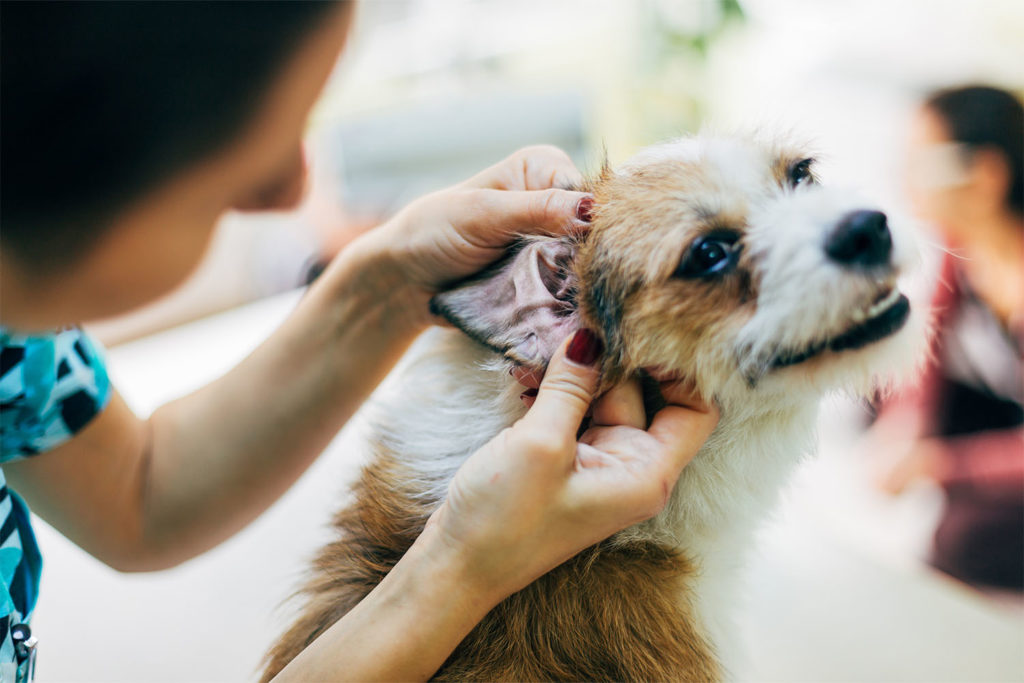Your dog’s ears may be adorable, but their anatomy also makes them prone to developing infections. Dog ears yeast infection issues can quickly become chronic, but knowing what causes them and how to prevent them isn’t as challenging as you may think.
We have a guide to ear yeast infections in dogs, including symptoms, potential treatment, and prevention techniques to keep your dog happy and healthy for years to come.
The Anatomy of Your Dog’s Ears
To understand how dogs can develop a yeast infection in their ears, you first have to understand your dog’s ears. Although there are a lot of similarities between how our pets’ bodies function and our own, your dog’s ears have a slightly different structure that makes them more prone to developing ear infections.
There are three parts of a dog’s ear — the inner ear, middle ear, and outer ear. These three parts work together to help your dog hear but also to help them balance.
The inner ear is where both essential parts of that functionality originate. The vestibular system, known as the organ of balance, and the spiral-shaped cochlea, which allows your dog to hear, are located the furthest inside the ear canal. Being deep inside the ear also gives them an extra layer of protection from damage due to external trauma.
The middle ear has a lot more working parts. It houses the eardrum (tympanic membrane) and multiple tiny muscles and bones. The middle ear is also connected to the back of the nose via the eustachian tube, which allows small amounts of air in.
And finally, the outer ear. The outer ear consists of all the parts you can see when you look at your dog. The actual “ear” itself is known as the pinna. In addition to looking cute, they are also designed to capture sound waves and funnel them into the ear canal, which transports them to the eardrum. The canine ear canal is far deeper than the human ear canal, which explains why dogs can hear four times better than we can (and at much higher frequencies).
What Is Yeast and How Does It Get Inside My Dog’s Ears?
Yeast is a fungus, and two types of yeast are most frequently found in dogs’ ears — Candida and Malesszia. Both types are not abnormal and are often a normal part of the microbiome. The problem happens when they are allowed to grow out of control, triggering an infection.
The size and shape of your dog’s ear canal have a lot to do with why they are so prone to developing yeast infections. Yeast thrives in warm, moist environments, and the depth of the ear canal gives them just that (especially if your dog loves to swim in the summer or gets regular baths.
Dog ears and yeast infections may go hand-in-hand if your dog is also dealing with an underlying condition that impacts the ears, like allergies, a ruptured ear drum, or a polyp inside the ear canal. Dogs with “floppier” ears, like Bassett Hounds and Cocker Spaniels, are also at increased risk, so it’s important to stay vigilant with their health.
As a side note, dogs who deal with chronic yeast can also develop it on other parts of their bodies, especially their feet. This can lead to a vicious cycle, where your dog uses its paw to scratch its ear, continuing the spread of yeast between the two indefinitely.
What Are the Symptoms of Dog Ears Yeast Infection?
Probably the most obvious symptom that your dog may be dealing with is a yeast infection of the ear is that they will be itching — a lot. A dog itching its ear isn’t unusual, but a dog with a yeast infection of the ear will be digging at it.
Some dogs will itch so hard that they may cry out in pain or even make their ears bleed. You may also see them rubbing their faces on their beds, the carpet, or anything else they can reach (especially older dogs without the same flexibility they may have had in their younger years).
However, itching isn’t the only sign of something happening inside your dog’s ear. You should also be on the lookout for the following:
- Balance issues
- Crusted fur or skin on and around the pinna
- Discharge from the ear, often brown or yellow, but can also be bloody
- Excessive shaking of the head
- Hair loss around the base of the ear (especially with chronic yeast infections)
- Head tilting
- Odor
- Redness of the pinna
- Swelling
Early recognition of the signs can help catch an infection before it can spread deeper inside the ear, reducing the risk of more severe complications.
How Is a Yeast Infection of the Ear Diagnosed?
If your dog has been incessantly digging at their ears, and you’ve noticed that tell-tale “yeasty” odor emanating from them, your first stop should be your veterinarian’s office.
Your dog’s vet will likely start by looking at their ears externally and internally (using an otoscope). Although the otoscope may not be the most comfortable tool to use on a dog with an irritated, inflamed ear canal, it’s crucial for helping to check the status of the eardrum and rule out any foreign bodies. Treatment options may change if the eardrum is ruptured.
An otoscope exam can also give your veterinarian another crucial piece of information — where in the ear the infection is located. The most common area of the ear to become infected is the outer ear, a condition known as otitis externa.
Otitis media (an infection of the inner ear) and otitis interna (an infection of the inner ear) are less common but also potentially have more significant complications.
Many veterinarians will also take a sample of any discharge or material inside the ear so that they can look at it under a microscope. Evaluating it this way can help verify the presence of yeast or check for any bacteria, guiding them toward the most effective treatment method.
How Are Dog Ear Yeast Infections Treated?
Once your vet has diagnosed your dog with a yeast infection of the ear, the next step is to treat it. Treatment will depend on where the infection is located in the ear. If the yeast is mainly on the pinna and the outer ear, many vets will stick with a topical antifungal medication. Middle and inner ear infections require more systemic care, so you may be prescribed oral tablets.
Some dogs may also need regular ear cleaning at home, especially if they develop chronic or recurrent ear yeast infections. However, always see your vet to verify that your dog’s eardrum is intact before starting this on your own.
What Complications Can Occur Because of a Yeast Infection of the Ear?
While most dog ears yeast infections are more irritating than dangerous, there are some potential complications. If not caught and treated quickly, an ear infection can spread from the outer ear into the middle and even the inner ear (which houses those crucial centers of hearing and balance).
Infections in these areas are not only more painful but can also lead to permanent hearing loss, coordination issues, and neurological damage.
Middle and inner ear infections can also trigger a condition known as vestibular disease. Vestibular disease looks similar to a stroke, as dogs will stumble around (ataxia) or walk in circles, have unusual back-and-forth darting eye movements (nystagmus), tilt their heads, drool, and even vomit. Treatment is often symptomatic but is more extensive and lengthy than catching and treating an early ear infection.
Can You Prevent Dog Ears Yeast Infections?
Like with most medical conditions, prevention is crucial. Make checking your dog out part of your daily petting ritual, looking not only for ear odor or discharge but other lumps, bumps, or abnormalities.
If your dog is a swimmer or gets bathed regularly, try to gently dry their outer ears out as much as you can afterward. You don’t need to get down inside the ear canal, but removing excess water can help remove the conditions that cause yeast to thrive.
Some people like to put cotton balls in their dog’s ears (not inside the ear canal, but just at the top) before bathing them to prevent water from entering their ears, too. Check with your veterinarian to see if this would be safe and useful for your dog.
Managing any underlying issues contributing to your dog’s frequent ear infections is also vital, especially if they suffer from allergies.
In Summary
Our dog’s ears may love a good scratch, but the same anatomy that makes them irresistible also makes them more prone to developing an infection. Dog ears yeast infections may be common but, if left untreated, can become a more significant issue with far more long-term consequences.
Make a point to check your dog’s ears for odor or discharge, and watch for excessive itching or head shaking to help catch an infection early and get it treated before it worsens. Your pet will be healthier and far more comfortable, and you can enjoy being a pet parent with less worry.
Sources:
Ear Structure and Function in Dogs – Dog Owners | Merck Veterinary Manual
Ear Infections and Otitis Externa in Dogs | Merck Veterinary Manual
Otitis Media and Interna in Dogs – Dog Owners | Merck Veterinary Manual









